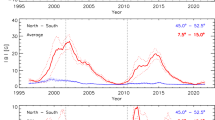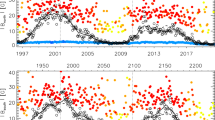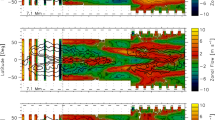Abstract
We study the hemispheric distribution of the kinetic helicity of subsurface flows in the near-surface layers of the solar convection zone and its variation with magnetic activity. We determine subsurface flows with a ring-diagram analysis applied to Global Oscillation Network Group (GONG) Dopplergrams and Dynamics Program data from the Michelson Doppler Imager (MDI) instrument onboard the Solar and Heliospheric Observatory (SOHO). We determine the average kinetic helicity density as a function of Carrington rotation and latitude. The average kinetic helicity density at all depths and the kinetic helicity, integrated over 2 – 7 Mm, follow the same hemispheric rule as the current/magnetic helicity proxies with predominantly positive values in the southern and negative ones in the northern hemisphere. This holds true for all levels of magnetic activity from quiet to active regions. However, this is a statistical result; only about 55 % of all locations follow the hemispheric rule. But these locations have larger helicity values than those that do not follow the rule. The average values of helicity density increase with depth for all levels of activity, which might reflect an increase of the characteristic size of convective motions with greater depth. The average helicity of subsets of high magnetic activity is about five times larger than that of subsets of low activity. The solar-cycle variation of helicity is thus mainly due to the presence or absence of active regions. During the rising phase of cycle 24, locations of high magnetic activity at low latitudes show a weaker hemispheric behavior compared to the rising phase of cycle 23.













Similar content being viewed by others
References
Bao, S., Zhang, H.: 1998, Patterns of current helicity for the twenty-second solar cycle. Astrophys. J. Lett. 496, L43 – L46. 10.1086/311232 . 1998ApJ...496L..43B .
Basu, S., Antia, H.M., Bogart, R.S.: 2004, Ring-diagram analysis of the structure of solar active regions. Astrophys. J. 610, 1157 – 1168. 10.1086/421843 . 2004ApJ...610.1157B .
Berger, M.A., Field, G.B.: 1984, The topological properties of magnetic helicity. J. Fluid Mech. 147, 133 – 148. 10.1017/S0022112084002019 . 1984JFM...147..133B .
Brun, A.S., Miesch, M.S., Toomre, J.: 2004, Global-scale turbulent convection and magnetic dynamo action in the solar envelope. Astrophys. J. 614, 1073 – 1098. 10.1086/423835 . 2004ApJ...614.1073B .
Corbard, T., Toner, C., Hill, F., Hanna, K.D., Haber, D.A., Hindman, B.W., Bogart, R.S.: 2003, Ring-diagram analysis with GONG++. In: Sawaya-Lacoste, H. (ed.) GONG+ 2002. Local and Global Helioseismology: The Present and Future, ESA SP-517, 255 – 258. 2003ESASP.517..255C .
Egorov, P., Rüdiger, G., Ziegler, U.: 2004, Vorticity and helicity of the solar supergranulation flow-field. Astron. Astrophys. 425, 725 – 728. 10.1051/0004-6361:20040531 . 2004A%26A...425..725E .
Fisher, G.H., Longcope, D.W., Linton, M.G., Fan, Y., Pevtsov, A.A.: 1999, The origin and role of twist in active regions. In: Nunez, M., Ferriz-Mas, A. (eds.) Stellar Dynamos: Nonlinearity and Chaotic Flows, ASP Conf. Ser. 178, 35 – 42. 1999ASPC..178...35F .
Gao, Y., Zhao, J., Zhang, H.: 2012, Analysis on correlations between subsurface kinetic helicity and photospheric current helicity in active regions. Astrophys. J. Lett. 761, L9. 10.1088/2041-8205/761/1/L9 . 2012ApJ...761L...9G .
Gao, Y., Zhao, J., Zhang, H.: 2013, A study of connections between solar flares and subsurface flow fields of active regions. Solar Phys. 10.1007/s11207-013-0274-z . 2013SoPh..tmp...75G .
Gizon, L., Duvall, T.L., Jr.: 2003, Supergranulation supports waves. In: Sawaya-Lacoste, H. (ed.) GONG+ 2002. Local and Global Helioseismology: The Present and Future, ESA SP-517, 43 – 52. 2003ESASP.517...43G .
González Hernández, I., Komm, R., van Driel-Gesztelyi, L., Harra, L., Baker, D., Howe, R.: 2013, Subsurface flows associated with non-Joy oriented active regions: A case study. J. Phys. Conf. Ser. 440, 012050. 10.1088/1742-6596/440/1/012050 .
Gosain, S., Pevtsov, A.A., Rudenko, G.V., Anfinogentov, S.A.: 2013, First synoptic maps of photospheric vector magnetic field from SOLIS/VSM: Non-radial magnetic fields and hemispheric pattern of helicity. Astrophys. J. 772, 52. 10.1088/0004-637X/772/1/52 . 2013ApJ...772...52G .
Haber, D.A., Hindman, B.W., Toomre, J., Bogart, R.S., Larsen, R.M., Hill, F.: 2002, Evolving submerged meridional circulation cells within the upper convection zone revealed by ring-diagram analysis. Astrophys. J. 570, 855 – 864. 10.1086/339631 . 2002ApJ...570..855H .
Hagino, M., Sakurai, T.: 2005, Solar-cycle variation of magnetic helicity in active regions. Publ. Astron. Soc. Japan 57, 481 – 485. 2005PASJ...57..481H .
Komm, R.W.: 2007, Value-added maps: Fluid-dynamics descriptors from ring diagrams. Astron. Nachr. 328, 269 – 272. 10.1002/asna.200610729 . 2007AN....328..269K .
Komm, R., Gosain, S., Pevtsov, A.: 2013, Active regions with superpenumbral whirls and their subsurface kinetic helicity. Solar Phys. 10.1007/s11207-012-0218-z . 2013SoPh..tmp...15K .
Komm, R., Corbard, T., Durney, B.R., González Hernández, I., Hill, F., Howe, R., Toner, C.: 2004, Solar subsurface fluid dynamics descriptors derived from Global Oscillation Network Group and Michelson Doppler Imager data. Astrophys. J. 605, 554 – 567. 10.1086/382187 . 2004ApJ...605..554K .
Komm, R., Howe, R., Hill, F., González-Hernández, I., Toner, C., Corbard, T.: 2005, Ring analysis of solar subsurface flows and their relation to surface magnetic activity. Astrophys. J. 631, 636 – 646. 10.1086/432413 . 2005ApJ...631..636K .
Komm, R., Howe, R., Hill, F., Miesch, M., Haber, D., Hindman, B.: 2007, Divergence and vorticity of solar subsurface flows derived from ring-diagram analysis of MDI and GONG data. Astrophys. J. 667, 571 – 584. 10.1086/520765 . 2007ApJ...667..571K .
Krause, F., Raedler, K.-H.: 1980, Mean-Field Magnetohydrodynamics and Dynamo Theory, Pergamon Press, Oxford, 19 – 44. 1980opp..bookR....K .
Lesieur, M.: 1987, Turbulence in Fluids. Stochastic and Numerical Modelling, Martinus Nijhoff Publishers, Dordrecht, 66 – 73. 1987tfsn.book.....L .
Longcope, D.W., Fisher, G.H., Pevtsov, A.A.: 1998, Flux-tube twist resulting from helical turbulence: The sigma-effect. Astrophys. J. 507, 417 – 432. 10.1086/306312 . 1998ApJ...507..417L .
Maurya, R.A., Ambastha, A., Reddy, V.: 2011, Kinetic and magnetic helicities in solar active regions. J. Phys. Conf. Ser. 271, 012003. 10.1088/1742-6596/271/1/012003 . 2011JPhCS.271a2003M .
Miesch, M.S.: 2005, Large-scale dynamics of the convection zone and tachocline. Living Rev. Solar Phys. 2(1). 10.12942/lrsp-2005-1 . 2005LRSP....2....1M . http://solarphysics.livingreviews.org/Articles/lrsp-2005-1/ .
Moffatt, H.K., Tsinober, A.: 1992, Helicity in laminar and turbulent flow. Annu. Rev. Fluid Mech. 24, 281 – 312. 10.1146/annurev.fl.24.010192.001433 . 1992AnRFM..24..281M .
Pevtsov, A.A., Longcope, D.W.: 2007, Helicity as the ultimate test to the surface dynamo problem. In: Shibata, K., Nagata, S., Sakurai, T. (eds.) New Solar Physics with Solar-B Mission, ASP Conf. Ser. 369, 99 – 102. 2007ASPC..369...99P .
Pevtsov, A.A., Canfield, R.C., Latushko, S.M.: 2001, Hemispheric helicity trend for solar cycle 23. Astrophys. J. Lett. 549, L261 – L263. 10.1086/319179 . 2001ApJ...549L.261P .
Pevtsov, A.A., Canfield, R.C., Metcalf, T.R.: 1995, Latitudinal variation of helicity of photospheric magnetic fields. Astrophys. J. Lett. 440, L109 – L112. 10.1086/187773 . 1995ApJ...440L.109P .
Seehafer, N.: 1996, Nature of the α effect in magnetohydrodynamics. Phys. Rev. E 53, 1283 – 1286. 10.1103/PhysRevE.53.1283 . 1996PhRvE..53.1283S .
Zhang, M.: 2006, Helicity observations of weak and strong fields. Astrophys. J. Lett. 646, L85 – L88. 10.1086/506560 . 2006ApJ...646L..85Z .
Zhao, J., Kosovichev, A.G.: 2003, Helioseismic observation of the structure and dynamics of a rotating sunspot beneath the solar surface. Astrophys. J. 591, 446 – 453. 10.1086/375343 . 2003ApJ...591..446Z .
Zhao, J., Kosovichev, A.G.: 2004, Torsional oscillation, meridional flows, and vorticity inferred in the upper convection zone of the Sun by time-distance helioseismology. Astrophys. J. 603, 776 – 784. 10.1086/381489 . 2004ApJ...603..776Z .
Acknowledgements
This work utilizes GONG and SOLIS data obtained by the NSO Integrated Synoptic Program (NISP), managed by the National Solar Observatory, which is operated by the Association of Universities for Research in Astronomy (AURA), Inc. under a cooperative agreement with the National Science Foundation. GONG data were acquired by instruments operated by the Big Bear Solar Observatory, High Altitude Observatory, Learmonth Solar Observatory, Udaipur Solar Observatory, Instituto de Astrofísica de Canarias, and Cerro Tololo Interamerican Observatory. The ring-fitting analysis is based on algorithms developed by Haber, Hindman, and Larsen with support from NASA and Stanford University. SOHO is a mission of international cooperation between ESA and NASA. This work was supported by NSF/SHINE Award No. 1062054 to the National Solar Observatory. RK was partially supported by NASA grant NNX10AQ69G to Alysha Reinard. We thank the reviewer for making this a better paper.
Author information
Authors and Affiliations
Corresponding author
Rights and permissions
About this article
Cite this article
Komm, R., Gosain, S. & Pevtsov, A.A. Hemispheric Distribution of Subsurface Kinetic Helicity and Its Variation with Magnetic Activity. Sol Phys 289, 2399–2418 (2014). https://doi.org/10.1007/s11207-014-0477-y
Received:
Accepted:
Published:
Issue Date:
DOI: https://doi.org/10.1007/s11207-014-0477-y




